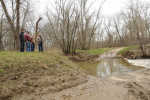Commissioners discuss options for replacing low water bridge

Vernon County commissioners Everett Wolfe, Bonnie McCord and Neal Gerster met with the Missouri Department of Transportation area engineer Darin Hamelink on Tuesday to visit and discuss a proposed bridge site on Stokes Road, about five miles southwest of Nevada.
The site on Little Drywood Creek currently has a low water crossing that has become an important thoroughfare for area residents and farmers after a nearby bridge on Tally Bend Road was closed. Some residents use Stokes Road and the low-water crossing to detour around the closed bridge.
In dry weather, the crossing is difficult to maneuver, but when it rains, the crossing is impassable.
A visit to the site on Tuesday showed well over a foot of water flowing swiftly over the road and it was easy to see that, at some point in the last few days water had been several feet over the crossing.
Gerster, who serves as northern commissioner, said even under good conditions, the crossing can be difficult for farmers to navigate with farm equipment.
The road approaching the crossing from both directions makes hard turns just before dropping downhill to the creek. The banks are high on both sides, making maneuverability even more difficult. The four discussed the need to raise any bridge to get away from the steep banks. As the commissioners and Hamelink looked at the situation on site, they tried to determine whether a new bridge should be built upstream or downstream from the present location.
Hamelink said department engineers would have to study some aerial photographs to determine the best place to locate the bridge. Either location offers a good opportunity to straighten out the route and avoid the sharp curves approaching the site now, but Hamelink did not recommend a new low-water crossing.
"I think that with as much water as that's carrying, you'd be better off building a new bridge," he said.
Hamelink also said he thought the project would qualify as a "BRO" project. Many of the county's bridges have been replaced with the Bridge Replacement Off or BRO system. Under that system, 80 percent of the cost is covered by federal funds and the county pays the other 20 percent.
What's more, a mechanism is in place to reimburse the county for its 20 percent, which means bridges can be built at no cost to a county.
Gerster told Hamelink to "go ahead and get the ball rolling, get it started."
The low water crossing has long been a problem for some residents who move machinery through the area, but it became more important after the Tally Bend Road bridge was closed a few weeks ago.
Before heading out to the Stokes Road site, Hamelink and the commissioners discussed some options for replacing culverts and smaller bridges and getting a soft match credit. Hamelink said some counties have tried using railroad flatcars as part of their bridge structure, but they are a poor choice because they tend to be worn or stressed. If the car is sound, however, it is an acceptable method.
Hamelink said tanker cars can be used as culverts. The main concern is what had been hauled in the car. A car that carried molasses, would be OK, but not a car used to haul oil.
The group also discussed the use of box culverts.
